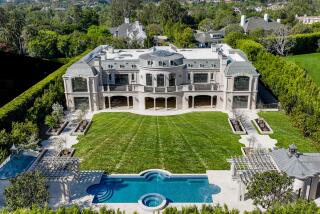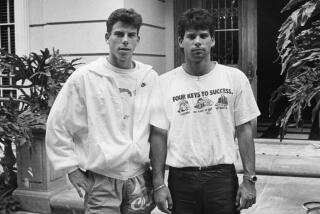Coke Castle : A Drug Kingpin Lived High and Mighty but Now He’s in Prison and the U.S. Is Selling
- Share via
SONOMA, Calif. — Through wisps of fog that often hover below Rudolph Henderson’s hilltop mansion, vineyards stretch toward a faint silhouette of San Francisco’s skyline, painting a breathtaking picture.
It was here, in this secluded hideaway, that Henderson enjoyed a lavish lifestyle far removed from the inner city’s drugs and crime, where he used his ties to Colombia’s infamous Medellin cocaine cartel to build the largest illegal narcotics trade in Oakland.
After his arrest for conspiracy to sell cocaine in 1987, he watched the signs of that life erode. First, they took his freedom, sentencing him to a 25-year term in federal prison. Then they auctioned his prized collection of antique automobiles. His opulent home, the last to go, was offered at auction Saturday.
Officials started the bidding at $1 million, but from the crowd of 50 prospective buyers, only one made an offer--for $750,000. Privately, federal authorities said they had hoped the house would fetch at least $2 million.
“We will consider the bid,” said Alfonso Mendez, who manages real estate seized by the government. “There might be another auction if the U.S. Marshal’s Service is not happy with it.”
The buyer inherits what is easily one of the most luxurious houses to go on the federal auction block in recent memory, say government officials. The looming, wood-shingled towers, spacious windows, spiraling stairs and eccentric past owners have made this 6,400-square-foot home a neighborhood landmark tainted by a legacy of cocaine trafficking.
“This was a place where Henderson could keep himself and his family out of sight and safe,” said Mendez. “It is also a place where you might someday knock on one of those stones alongside the house and find that it’s hollow.”
Perched on one of the tall, rolling hills overlooking Sonoma, the mansion was built for Michael Blevins, a friend of Henderson who demanded that his home be constructed to exacting standards, according to federal prosecutors and the building’s architect.
“He was easygoing and very pleasant but he also knew what he wanted,” said Victor Conforti, a Sonoma architect who designed the mansion in 1984.
Blevins’ dream home--which he never moved into but sold to Henderson in the mid-1980s--included more than $80,000 of woodwork: solid mahogany cabinets and doors and oak floors.
Just outside the mansion, between an unkempt Japanese rock garden and a heated pool, is a satellite dish hooked to sockets in a spacious dining room, the master bedroom and to a big-screen television in the den. There is an industrial kitchen with a brick niche for smoking meat. The five bathrooms--one in the garage, another next to the pool, the rest in the house--often outnumbered the home’s residents.
In its heyday, the mansion was guarded by Doberman attack dogs, an elaborate arsenal of television cameras and more than a mile of wire-mesh fences hooked to a security system. The fences are still there, but the cameras and dogs are gone.
Before the swimming pool was installed in the back yard, neighbors remember helicopters touching down in the clearing under the cover of night. Things calmed down after Henderson moved in, but after his arrest, residents complained that the home was attracting too much attention.
At night, speculators would vault over the fence to dig up the lawn, searching for money they suspected Henderson had buried. Real estate bargain hunters from all over the state flooded government switchboards and drove up the narrow road to catch a glimpse of the house during the day.
More to Read
Sign up for Essential California
The most important California stories and recommendations in your inbox every morning.
You may occasionally receive promotional content from the Los Angeles Times.













